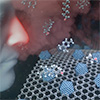| May 02, 2025 |
This technology converts scent molecules into electrical signals and trains AI models on their unique patterns. It holds great promise for applications in personalized healthcare, the cosmetics industry, and environmental monitoring.
(Nanowerk News) A research team led by Professor Hyuk-jun Kwon of the Department of Electrical Engineering and Computer Science at DGIST, with integrated Master’s and Ph.D. student Hyungtae Lim as first author, has developed a “next-generation AI electronic nose” capable of distinguishing scents like the human olfactory system does and analyzing them using artificial intelligence.
|
|
This technology converts scent molecules into electrical signals and trains AI models on their unique patterns. It holds great promise for applications in personalized healthcare, the cosmetics industry, and environmental monitoring.
|
|
The research has been published in ACS Nano (“Intelligent Olfactory System Utilizing In Situ Ceria Nanoparticle-Integrated Laser-Induced Graphene”).
|
|
While conventional electronic noses (e-noses) have already been deployed in areas such as food safety and gas detection in industrial settings, they struggle to distinguish subtle differences between similar smells or analyze complex scent compositions. For instance, distinguishing among floral perfumes with similar notes or detecting the faint odor of fruit approaching spoilage remains challenging for current systems. This gap has driven demand for next-generation e-nose technologies with greater precision, sensitivity, and adaptability.
|
|
The research team was inspired by the biological mechanism known as combinatorial coding, in which a single odorant molecule activates multiple olfactory receptors to create a unique pattern of neural signals. By mimicking this principle, the team engineered sensors that respond to scent molecules by generating distinct combinations of electrical signals. The AI system learns these complex signal patterns to accurately recognize and classify a wide variety of scents, resulting in a high-performance artificial olfaction platform that surpasses existing technologies.
|
|
The novel electronic nose uses a laser to process graphene and incorporates a cerium oxide nanocatalyst to create a sensitive sensor array. This single-step laser fabrication method eliminates the need for complex manufacturing equipment and enables high-efficiency production of integrated sensor arrays.
|
|
In performance tests, the device successfully identified nine fragrances commonly used in perfumes and cosmetics, with over 95% accuracy. It could also estimate the concentration of each scent, making it suitable for fine-grained olfactory analysis. The device is ultra-thin, flexible, and highly durable, making it ideal for wearable devices or bright patches attached to the skin or clothing. It can be bent more than 30,000 times around a 2.5-mm radius without any performance degradation.
|
|
“The core innovation of our research is the ability to integrate multiple scent-sensitive sensors with diverse properties, similar to those of the human nose, into a single unit through a one-step selective laser fabrication process,” said Professor Kwon. “We are actively expanding development and commercialization efforts to apply this technology to personal healthcare, environmental pollution detection, and the fragrance industry.”
|

